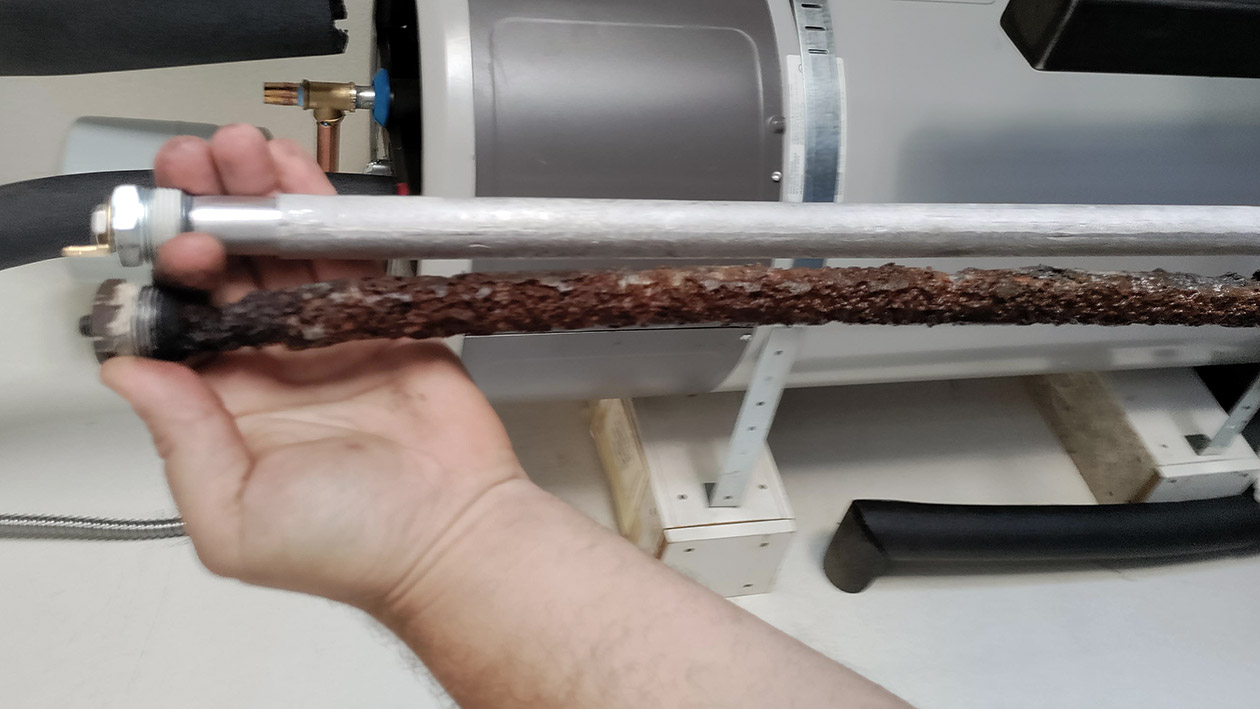Replacing a hot water anode rod is a crucial maintenance task. It prolongs your tank’s lifespan. This guide provides a step-by-step process. Follow these instructions for a successful replacement.
In this guide:
- What is a Hot Water Anode?
- Tools and Materials Required
- Do You Have to Drain the Water Heater to Replace the Anode Rod?
- How Often Should a Hot Water Heater Anode Rod Be Replaced?
- How Much Does it Cost to Replace an Anode Rod in a Hot Water Tank?
- How Do I Know if My Hot Water Heater Anode is Bad?
- How Do I Know What Size Anode Rod I Need?
- Can I Replace an Anode Rod Myself?
What is a Hot Water Anode?
Within the armour of your water heater, a sacrificial anode rod stands as the unsung hero prolonging the unit’s life. This rod, typically made from magnesium, aluminium, or zinc, subscribes to a destiny of self-sacrifice. By offering itself up to corrosion, the metal of the anode attracts corrosive elements in the water, deflecting them from the tank walls. Over time, the degradation of this rod necessitates its replacement to ensure the continued protection of the tank.
Replacement involves selecting the right metal for your water heater’s anode rod; each carries distinct properties ideal for various water conditions. A magnesium rod excels in softer water, while aluminium is chosen for areas with hard water notorious for high calcium content. Zinc, often added to aluminium rods, combats the odious sulphur smell that can plague water systems.
Tools and Materials Required
- Socket wrench set
- Adjustable wrench
- Pipe wrench
- Garden hose
- Bucket
- New anode rod (correct size for your water heater)
- Thread sealant tape (PTFE tape)
- Penetrating oil (optional)
Step-by-Step Guide to Replacing a Water Heater Anode
- Turn off the water heater’s power supply. Turn off the electricity at the circuit breaker. Turn off the gas supply if you have a gas water heater.
- Turn off the cold water supply to the tank. Locate the valve. Turn it clockwise.
- Attach a garden hose to the drain valve. Place the other end into a bucket or suitable drain.
- Open the drain valve and drain some water from the tank. This reduces pressure and makes anode removal easier.
- Locate the anode rod. It’s typically on top of the water heater. It might be under a plastic cap.
- Apply penetrating oil to the area around the anode rod base. This helps loosen it (optional). Let it sit for a few minutes.
- Use a socket wrench (or impact wrench with caution) to loosen and remove the anode rod. Turn it anticlockwise. Be prepared for some resistance. Have another wrench to hold the tank steady.
- Inspect the old anode rod. A heavily corroded rod confirms the need for replacement.
- Clean the threads of the anode rod opening. Ensure a good seal for the new rod.
- Wrap the threads of the new anode rod with PTFE tape. This ensures a watertight seal.
- Insert the new anode rod. Tighten it clockwise by hand. Then, use the socket wrench for the final tightening. Don’t overtighten.
- Close the drain valve.
- Remove the garden hose.
- Turn the cold water supply back on. Check for leaks around the new anode rod.
- Turn the power supply back on. This restores the normal operation of your water heater.
Do You Have to Drain the Water Heater to Replace the Anode Rod?
Yes, draining the water heater is generally necessary for anode rod replacement. Draining reduces the pressure inside the tank. This makes removing the old anode rod significantly easier. A full drain isn’t always mandatory. However, draining enough water to lower the pressure below the anode rod connection is essential. Some methods allow for replacement with minimal draining. These include using a wet/dry vacuum to remove water directly from the top of the tank. Consult your water heater’s manual. It will explain the recommended method for your specific model. Safety is paramount when working with a water heater. Always turn off the power and water supply before starting any work.
How Often Should a Hot Water Heater Anode Rod Be Replaced?
Anode rods have varying lifespans. Several factors influence their lifespan. Water chemistry is the most important factor. Soft water is less corrosive. Hard or acidic water accelerates anode rod degradation. Usage frequency also plays a role. Frequent hot water usage means faster depletion of the anode rod. Generally, anode rods last between 3 to 5 years. In some cases, they might last longer or shorter periods. Regularly inspecting the anode rod is crucial. Early replacement prevents potential damage to your water heater tank.
Signs of a Failing Anode Rod
- Reduced hot water capacity
- Potential changes in hot water temperature
- Discoloured or rusty water
- Sulphur or rotten egg smell from the hot water
Inspect the anode rod annually and replace it if it shows significant corrosion or thinning. This preventative maintenance saves money in the long run, as replacing the anode is cheaper than replacing the entire tank.
How Much Does it Cost to Replace an Anode Rod in a Hot Water Tank?
Replacing an anode rod in a hot water tank in Australia can cost as low as $75-$135 (excluding GST) for a standard-sized anode. The anode rod itself typically costs between $50-$200, depending on the size and type. For example, a 500mm magnesium anode costs around $67, while a 1210mm magnesium anode costs about $143. When factoring in the labour and service fees of a professional hot water plumber, the total cost for professional anode replacement can range from $200 to $600. Several factors can influence the final price of anode replacement:
- Size and type of anode: Longer anodes or specialized types (e.g., flexible anodes) may cost more.
- Accessibility: If the water heater is in a hard-to-reach location, it may increase labour costs.
- Type of water heater: Solar roof tanks may incur additional charges.
Remember, replacing an anode (costing $50-$460) is much cheaper than the price of replacing a hot water system, costing $1,200-$3,000.
How Do I Know if My Hot Water Heater Anode is Bad?
Inspecting the anode rod visually helps determine its condition. A worn-out anode rod shows signs of significant corrosion and/or rust. It might appear thinner. The core wire might be exposed. The metal might be heavily pitted or even broken. Sometimes, the rod almost disappears. Only a small stub remains. These are all indications that the anode rod needs replacing.
Several factors cause anode rod degradation. The primary factor is water chemistry. Hard water, acidic water, or water with high mineral content corrodes the anode rod faster. High water temperatures also contribute to faster wear. Regular inspections are important, especially if your water supply is known to be harsh.
How Do I Know What Size Anode Rod I Need?
Water heaters use different anode rod sizes. The correct size depends on your specific water heater model. Check your water heater’s manual. It will specify the correct rod size and type. Measuring the old anode rod also provides a good indication.
Not all water heaters use the same anode rod. Sizes and materials vary. Common lengths are 30 inches, 36 inches, and 42 inches. Some tanks have a dedicated opening for the anode rod. Others combine the anode rod with the hot water outlet. This is known as a combination anode/outlet.
Some water heaters have two anode rods. This is more common in larger tanks or tanks prone to corrosion. If your water heater has two rods, replace both simultaneously. Using the correct size and type for each location is essential. Consult your water heater’s documentation for specific requirements.
Can I Replace an Anode Rod Myself?
Replacing an anode rod is a DIY-able task for many homeowners. It requires some basic plumbing knowledge. Having the right tools is also important. However, some situations require professional assistance. A seized anode rod often needs a professional plumber. Complex water heater setups might also necessitate expert help.
Using an impact driver to remove an anode rod presents risks. It can damage the tank. Use an impact driver with extreme caution. If uncertain, a standard socket wrench is the safer option.
Assess your skills honestly. If you are unsure about any part of the process, contact a qualified plumber. Professional installation ensures proper sealing and prevents potential damage to your water heater.



